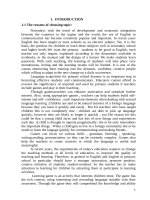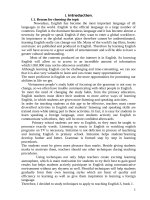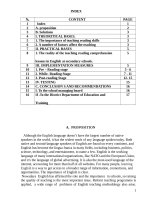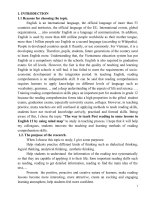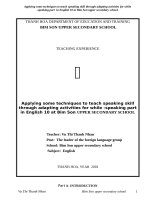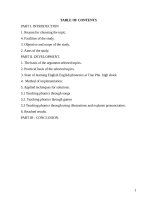Using some techniques in teaching reading skill in english 9
Bạn đang xem bản rút gọn của tài liệu. Xem và tải ngay bản đầy đủ của tài liệu tại đây (2.09 MB, 21 trang )
PART 1:
INTRODUCTION
1. Rationale
Resolution No. 29-NQ/TW of November 04, 2013, on “fundamental and
comprehensive innovation in education, serving industrialization and
modernization in a socialist-oriented market economy during international
integration” ratified in the 8th session.
Party and State identify the targets of innovation is to create chages
fundamentally, strongly in quality and efficency of education and training.
Vietnamese people are educated comprehensive development and promote each
individual's potential and creativity. To improve comprehension education, to
focus on ideal, traditional, ethnic education. To educate lifestyle, foreign
languages, informatic technology, abitity and skills. To develop creativity, selflearning, encourage lifelong learning.
Thus, the content of this innovation, the Party and the State has focused
on teaching - learning a foreign language in general education programs,
especially the English-language professional English has become the common
language of the world. It plays a very important role in the formation and
construction of new people to meet the requirements of industrialization modernization in conditions of market economy socialist orientation and
international integration. Learning English can help students communicate with
friends in the world, master of knowledge of mankind. [1]
In Vietnam, English has been taught as an important foreign language for a
long time but due to grammar-translation method of teaching, Vietnamese
students seem to be better at grammar than communicative competence.
Therefore, according to a large project to investigate the English teaching reform
in northern parts of Vietnam, only 5% of students are able to communicate in
English after graduation [2]. This fact gives rises to the need for nationwide
innovation in the teaching methodology in the light of communicative approach.
Among various learning strategies, Reading is the most important skill in
English language from other language skills in acquiring language. If students
are good in reading, they will be good in other language skills (writing,
speaking, and listening). For this reason teachers of English language should
focus on this skill.
All the aforementioned conditions drive the author to carry out the
research “Experiences in using some techniques to teach reading skill lessons in
English 9 at Quang Phong secondary school”. Hopefully, this study will make a
small contribution to improving reading skills for grade 9 th students at Quang
Phong secondary school.
2. Aim and objectives
1
The aim of this study is to explore the exploitation of using techniques to
enhance students’ reading skill. In order to achieve the aim, the writer focuses on
finding out the benefits of applying techniques in reading lessons for grade 9 th
students.
3. Scope of the study
Acquiring reading skill is a vast issue in language learning. However, due
to the limit of time, experiences and knowledge, this study touches upon only
some techniques which are used in teaching reading skill and cannot cover all
the eading techniques in teaching and learning.
4. Methodology
The major method which was used in study is qualitative. All comments,
remarks, assumptions and conclusions of the study were based on the data and
analysis. Data collections for analysis in the study were gained through the
following resources: survey questionnaire, observations, tests for students, as
well as reference books. After the data were collected, they were categorized
and analyzed quantitatively and qualitatively to obtain the realistic results.
To end with, based on analysis of survey results and references, some
pedagogical implications and suggestions in order to improve teaching and
learning English reading using some techniques will be proposed.
PART 2:
CONTENTS
1. Theory background.
It is widely accepted argument that reading and listening go hand-in-hand
in any language learning, because reading provides a wide span of vocabulary
and listening helps to form exact utterance of words. This can be helpful for
foreign language learners who encounter hurdles in finding suitable words to
describe the situation. This problem is more a cute with the infrequent readers.
According to Bright and Mc Gregor (1970, p52), ‘where there is a little reading,
there will be little language learning. The students, who want to learn English,
will have to read unless they move onto speaking track’ [3]. Thus, it is clear that
reading not only develops writing skill but also helps in improving speaking
with speech fluency and sentence accuracy. It creates a sound understanding of
semantic and grammatical structure of the language. It is also believed that the
students who read a lot are likely to speak well. This is because ‘A text is usually
regarded as authentic if it is not written for teaching purposes but for a real-life
communicative purpose, where the writer has a certain message to pass on to
thereader. ‘An authentic text is one that possesses an intrinsically
communicative quality’ (Lee, 1995:324). With such advantages of reading in
improving and developing language skills, particularly speaking skills, this
paper investigates the relationship between reading habit and improving
2
speaking proficiency as reading enriches much needed vocabulary in EFL
context and also offers practical language in use with interesting examples from
various genres.
By raising students' awareness of reading as a skill that requires active
engagement, and by explicitly teaching reading strategies, Teachers help their
students develop both the ability and the confidence to handle communication
situations they may encounter beyond the classroom. In this way they give their
students the foundation for communicative competence in the new language.
Therefore, teachers have very important role to improve reading skills to their
students to improve other language skills . They can follow some stages and
strategies when teaching reading text. Reading strategies are defined as the
mental operations involved when readers approach a text effectively and make
sense of what they read
2. The current situation of teaching and learning reading comprehension at
Quang Phong secondary school
2.1. The problems of teaching and learning reading skills at the school
Some teachers complain that most students are not able to understand what
they read. Students hate to read, they only read the required textbook in order to
be able to set for the achievement routine exams. They lacked motivation to
read, even if they read, they show negative attitudes. For most of the learners,
reading is an extremely difficult task that requires integrated body of skills,
which also does not get easier with the passage of time and the accumulation of
experience.
In the first place, materials have been considered an important tool for
teaching and learning English. In secondary schools in Vietnam, the textbooks
are designed for all students of different grades. Among them, this study stresses
that using the same textbooks for all students in different regions is problematic.
In the other hand, the failure of students in reading may also originated
from the fact that the teaching and learning process of reading is not conducted
effectively and the inappropriate teaching method is applied by the teacher. In
other words, the students may find the strategies which the teachers use not
interesting and effective enough to develop their reading comprehension.
2.2. The school
This study was conducted at Quang Phong secondary school in Quang
Xuong district, Thanh Hoa province. In the school year 2017-2018, the school
had 8 classes with more than 300 students, among which there were 81 ninth
grade students divided into two classes, so there were about 40 students in each
class. One thing worth to note here is that the level of students at Quang Phong
3
secondary school is not very high. They mostly come from rural areas where
English teaching and learning has not been paid much attention to. Besides, the
school shares common features with classrooms elsewhere in Vietnam: large
size, students sitting in rows of four each and irremovable furniture
2.3. The students
Students under this investigation are 39 students of class 9B of Quang
Phong secondary school within the second semester from the 1 st February to the
April 29, 2018. There were 17 girls and 22 boys. They were the same age and
had the same total years of learning English with the same curriculum from
primary school to secondary school. Most of them could do grammar very well
but they have difficulties in comprehending the spoken language, especially in
one - way reading situations.
Difficulties are created by the students’ limited knowledge of the language
system and their lack of vocabularies. This is due to the inappropriate learning
strategies in reading, and the time limitation for teachers of English in class.
Each week, they had three forty - five minute English lessons and one more
selective lesson.
Since education reform, Students have loved leaning English but mainly
advanced students. And weak students who understand the lesson slowly learn
passively. They wait for the teacher's or other students' answers. Many of them
have no oppotunities or they don't dare to practise speaking English in class.
They are afraid that they will speak wrongly. Many can not read, speak, listen
and write, even they ignore paying attention to the lessons. In fact, we can see
these students have no love for English. Therefore, the teaching qualities of
English do not live up to our expectations
Following is the convey on the quality of English of two classes: 9B of
Quang Phong secondary school at he beginning of the first term in school year
2017-2018.
Number
Excellent
of
Class
students
Q
9B
39
0
%
0
Good
Q
3
%
7,7
Fair
Q
17
Poor
%
Q
43,6 11
%
28,2 8
Fail
20,5
From the matter of fact, as a teacher, I have endlessly been considering
and researching for the methods to improve the quality of teaching English
3. CONTENTS AND SOLUTIONS.
The stages and strategies of reading that teachers should promote for their
students are : Pre-reading, While reading and Post-reading stages . They are
very important when teaching any reading text. Each of these stages has its own
4
characteristics, although they are related to one another. That is, the pre-reading
stage leads to the while-reading stage and finally to the post-reading one. These
stages make the students understand and comprehend text reading.
Instruction in reading strategies is not an add-on, but rather an integral
part of the use of reading activities in the language classroom. Teachers can help
their students become effective readers by teaching them how to use strategies
before, during, and after reading.
Teachers can use the following teaching techniques in teaching reading
skill, especially in each stage: Pre – reading, While-reading and Post- reading
which make students get knowledge actively and creatively.
3.1. Pre- Reading stage.
In order to improve reading comprehension, students should be
encouraged to complete pre-reading activities before reading text. Familiarity
with the text improves understanding and leads to reading success. Establish a
purpose for reading. This should be done with every piece of text read. Teachers
have students determine what the primary outcome of reading the text should be.
To provide information? To provide entertainment? To gain understanding as to
how something works? It is helpful if the teacher establishes the purpose for
reading and then guide your students to that outcome.
The pre-reading stage also helps to make the next stages of reading more
easily adaptable for the reader. This is a plan for the reading task, so teacher
should show the students :
There are three steps in this stage: They are Lead-in, Read through and
teach some new words. In each step we can use different techniques to lead in
the reading task. These are some techniques which are used in this stage to help
and encourage many learners to sustain their interest and work.'[5]
3.1.1. Discussion.
In this part, teacher sets the scene to let students pay much attention to the
topic of the text.
Example 1: Unit 1-READ (page 9, 10) SGK English 9
Before reading a passage about the country Malaysia, Teachers let students
discuss these questions:
How many countries are there in Asean?
What are they?
- Let Students do the task Matching the name of country to their capital city.
Countries in Asean
Capital
Answer
1. Vietnam
A. Bangkok
1-E
2. Indonesia
B. Yangon
2-C
3. Malaysia
C. Jakarta
3-G
5
4. The Philipines
5. Singapore
6. Combodia
7. Laos
8. Thailand
D. Darussalam
E. Hanoi
F. Manila
G. Kuala Lumpur
H. Phnom penh
4-F
5-J
6-H
7-I
8-A
9. Brunei
10. East Timor
11. Myanmar
I. Vientian
J. Singapore
K.Dili
9-D
10- K
11-B
3.1.2. Pre- questions
Example 1: Unit 1-READ (page 9, 10) SGK English 9
Step 2. Read through.
- Let students read the text in silently in order to help them to approach the
topic and create the first impression on the topic, events, ….Then ask them some
questions about the text:
1. Where is it?
- It’s in Malaysia
2. What is the capital of Malaysia?
3. What is its population?
4. How big is Malaysia?
5. What language is spoken in this
country?
- These questions will be answered at the end of the lesson
Step 3. Teach some new words.
Using some techniques to teach these new words: divide (v); separate (v);
comprise (v); tropical country; religion; compulsory (a); official (a)….
Example 2. Unit 2 – READ (page 17) Text book: English 9
- The teacher shows the picture in page 17 and ask students some
questions which refer to the topic of the reading:
6
a. What do they do?
b. What are they wearing?
c. Are they nice? handsome?
d. Are jeans fashionable?
e. Do you like jeans?
- Call students to answer these questions.
- Let’s start to read a passage about the origin of jeans
3.1.3. Brainstorming:
- Divide class into 2 groups and let the play the game “ Brainstorming”.
Ask student to call out or write the words refer to the topic of the text. Let them
2 or 3 minutes to write the words on the board.
Example . Unit 2 – READ (page 17) Text book: English 9
Step 1: Lead - in
Before reading a passage about the origin of jeans, teacher let students
play a game called Brainstorming to remind the types of clothings.[4]
Plaid skirt
Jeans
T- shirt
Striped shirt
Types of
clothing
dress
Blue shorts
Short-sleeved blouse
Step 2. Teach some new words.
- Using techniques to introduce some new words: material, wear out,
embroidered, generation, sailor, sale…..
Example 2 . Unit 4 – READ ( page 36) Text book: English 9
7
Step 2. Teach some new words.
3.1.4. True/False statement prediction.
Teacher prepares some statements refers to the text. Some are true and
some are not true. Ask student to work in pairs/ groups to predict which
statement is true or false? Then call some pairs or groups to give their
prediction, write on the board and let the students check after reading the text.
Step 3. Read through.
Example 1 . Unit 2 – READ (page 17) SGK English 9
- Let students read through the text in silently in order to help them to
approach the topic and create the first impression on the topic, events, ….
- Give them some statements and ask them to predict which sentence is
True or False
Statements
Predict
Answer
key
1. Jeans was made in Europe
2. In the 19th century, Jean cloth was made completely
from cotton
3. In 1960s, A lot of university and college teachers
wore jeans
4. Jeans became more expensive so many people
began wearing jeans in the 1970s
5. Jeans became high fashion clothing in the 1980s
6. The sale of jeans stopped going up in 2000s
Example 2: Unit 9: READ (page 78,79) SGK English 9.
- Give them some statements refer to some natural disasters and ask
them to predict which sentence is True or False
8
Statements
Predict
Answer
key
1.Most of the earthquakes in the world occur in the
Ring of Fire
2- The earthquake in Kobe in 1995 caused severe
damage
3- A huge tidal wave traveled from California to Alaska
and hit Anchorage in the 1960s
4- Typhoon, hurricane and tropical storm are
different words for the same natural disaster.
5- The eruption of Mount Linatubo is the worlds
largest ever volcanic eruption.
6- A tornado looks like a funned shape
3.1.5.Ordering statements.
- Teacher prepares 6 or 8 sentences which refer to the content of the text.
Jumple the orders of these sentences and ask the students to rearrange them in
the correct order.
Example : Unit 3: A trip to the countryside - READ (page 25,26)
Give some jumble sentences and ask student to rearrange these sentences
into the correct order. Teacher can give 6-8 sentences.
1- He often does chore after school.
2- Van is living with the Parker family in America.
3- He will stay there till the beginning of October.
4- He feeds the chickens and collects their eggs.
5- Van is an exchange students from Ho Chi Minh city
6- The Parker are nice so Van feels like a member of their family.
The correct order is: 5 - 2- 1 – 4 – 3- 6
3.2. While- reading stage.
While-reading strategies can help the students to improve his ability to
become more fluent in English, especially in the areas of speaking and reading.
The while-reading activities I use in the classroom vary according to my aim in
using a particular text. Hopefully, such strategies will help them cope with
problematic and grayer areas of the text, such as identifying the main ideas of a
text, which are also problematic for them in their native or first language.
While-reading strategies are challenging and sometimes difficult to teach
and learn because different students need different strategies and not every
student can acquire the same proficiency level. I am not always sure which
strategies students need the most in the classroom and those which require more
practice at home. Hopefully, I will gain more insight as to which activities are
also suitable for each task.[5]
In this stage, teacher should monitor comprehension:
- Verify predictions and check for inaccurate guesses
- Decide what is and is not important to understand
9
- Reread to check comprehension
- Ask for help
There are two steps used in this stage: Read for main idea ( gist) and Read
for detail. In each step we can also use different techniques to help students to
do the task reading.
3.2.1.Grids or forms
Teacher asks students to read the text in silent and complete the grids or
forms.
Example: Unit 1 : A visit from a penpal – Read
Step 4. Read for main idea (Gist)
Ask students to read the passage then fill in the table with
the right information about Malaysia
1- Area………………………….….
5- Capital city……………………………
2- Population ……………………...
6- Oficial religion………………………
3- Climate ……………………..…..
7- National language …………………...
4- Unit of currency …………...……
8- Compulsory second
language………….
3.2.2. Checking True/False statements.
Example . Unit 2 - READ (page 17) SGK English 9
Step 4. Read for main idea (Gist)
In this step, Let students to read the text silently and check True/False
statement prediction
Statements
Predict Answer key
T
1. Jeans was made in Europe
th
2. In the 19 century, Jean cloth was made completely
F
from cotton
In the 18th
century
3. In 1960s, A lot of university and college teachers
T
wore jeans
4. Jeans became more expensive so many people
F
began wearing jeans in the 1970s
Cheap
5. Jeans became high fashion clothing in the 1980s
T
6. The sale of jeans stopped going up in 2000s
F
1990s
3.2.3. Multiple choice.
Example . Unit 2 - READ (page 17) SGK English 9
Teacher can also design a multiple choice exercise in this step.
1- More and more people started wearing Jeans in ………….
a- 1960s
b- 1970s
c- 1980s
2- The word Jean comes from a kind of meterial that was made in ……
10
a- Europe
b- America
c - Africa
3- More and more people started wearing jeans because they became……..
a- beautiful
b- cheaper
c- fashion
3.2.3. Gap-fill
This technique is used to check meaning of vocabularies, main idea or
detail. Teacher can summary the text in which have some blanks and ask
students to fill in the missing words/phrases.
Example 1. Unit 2 - READ (page 17) SGK English 9
Step 5: Read for detail
Group work: Let students read again the text, discuss in groups of 6 to do the
task:
Fill in the missing dates
1. _________: Workers liked to wear……. ……..because the material made from
cotton was very strong and could hardly wear out.
1. _________ : A lot of university and college………… wore jeans.
2. _________: Jeans became………. …..so many, many people began wearing
jeans.
3. __________: Jeans became high…………..clothing.
4. __________: The…………...of jeans stopped going up.
Example 2 : Unit 7: Saving energy – Read
After reading for gist and details about ways to save energy. Teacher can
design this exercise and ask student to complete the summary.
For most (1)…………American households, lighting accounts for
(2)…… percent to 15 percent of the electricity bill, (3)………this amount can be
reduce by replacing an (4)…………150 watt bulb with an energy saving bulb.
These bulbs use a (5)…………..of the electricity of (6)…………bulbs and last
eight times longer…
3.3.4. Comprehension questions
Step 5: Read for detail
Example 1 . Unit 2 - READ (page 17) SGK English 9
Let students to read again the text carefully and work in pairs ask and
answer these questions.
1. What does the word jeans com from?
2. What were the 1960s’ fashions?
3 . Why did more and more people begin wearing jeans in the
1970s?
4. When did jeans at last become high fashion clothing?
5.Why did the sale of jeans stop growing ?
Example 2 . Unit 5 - READ (page 43,44) Text book - English 9
- Let students read the three responses carefully then work in pairs asking
and answering these questions.
1. What does Sandra use internet for?
11
2. Why is it difficult for Honghoa to get access to the Internet?
3. According to Huansui, why do people use the Internet?
Question number 4 and 5: Ask students to work in groups to make a list of
benefits and disadvantages of the Internet
4. Make a list of benefits of the Internet according to three responses.
5. Are there any disadvantages of the Internet? If so, what are they?
3.2.5. Matching
Example 2 . Unit 5 - READ (page 33,34) Text book - English 9
After using some techniques to lead-in and to teach some new words.
Teacher uses these techniques to help students to get information from the text to
do some tasks.
12
Step 4. Read for main idea (Gist)
- Ask students to read three responses in a forum about the Internet. Scan
the text and match the folowing main ideas and the responses.
a. Students in the countryside can’t access to the Internet.
b. Internet is a wonderful invention.
c. The Internet can be limited in some ways.
- Students to work in groups and give answer:
a. Response #2
b. Response # 1
c. Response #3
3.2.6. Choose the best summary.
Example 2 : Unit 7: Saving energy – Read
Step 4. Read for main idea (Gist)
Have the students to read the passage more carefully and choose the best
summary for it among the following options.
1. Energy-saving bulbs should be used to save electricity.
2. In Western countries, electricity, gas, and water are necessities.
3. North American and European countries are interested in saving
money and natural resources.
4. Labeling schemes help save energy.
- Ask students to work n groups and to find out the best summary for the
passage.
- Call students to give their answers, teacher remarks and give answer key.
3. North American and European countries are interested in saving
money and natural resources.
Explaination: this is the best answer because three others are too specific.
They only cover one part of the passage.
3.2.7. Lucky number game.
Step 5: Read for detail
Example 2 : Unit 3: A trip to the countryside
Let students to read the text again, then play the game called Lucky number to
answer these questions.
Read and answer the questions
1. Who is Van?
2. Whom is he living with?
3. Where do the Parkers live?
4. What does Mr. Parker do?
5. What does Mrs. Parker do?
6. What does Van do in the afternoon?
13
Lucky numbers: 2,5,8,9
Answer : 1. He is an exchange student in the USA.
3. He’s living with the Parker family
4. They live on a farm100 kilometers outside Columbus, Ohio.
6. He a is a farmer.
7. She works part- time at a grocery store.
10. He feeds the chickens and collects their eggs.
3.3. Post-reading stage.
After or post-reading stage provide students a way to summarize, reflect,
and question what they have just read. They are an important component of the
pre-, while, and post-reading strategy and is the core of good comprehension.
Teacher demonstration and modeling of each post-reading strategy is
absolutely crucial in order for the strategy to be a success. Post-reading
strategies such as the ones mentioned above really drive home the fact that once
you have completed your reading, you still have to understand what you have
just read. Students need to summarize key points after reading to help them
comprehend the information that was learned, longer.[5]
This is further practice stage. It is used after while- reading to check and
drill. There are some activities in this stage such as: Roleplay, Interview, Recall
the story,Retelling, Write-it-up, Futher Practic, Summary & Opinion, Survey,
3.3.1. Roleplay.
Example 1 : Unit 1-A visit from a penpal - READ (page 9, 10)
- Ask students to play a role of Maryam who comes from Malaysia and
the other is a person who is going to have a summer vacation in Malaysia. Make
14
a dialogue to asks her some questions about her country. Using the information
in the text which has read.
A: Hi, Maryam. I am going to visit Malysia on my summer holiday.
I'd like to know something about your country. Can you help me?
B: Yes, certainly.
A: What language is spoken in your country?.
B: Bahasa Malaysia ,English, Chinesae, and Tamil are also widely
spoken.
A:............
Example 2: Unit 5: THE MEDIA – Read (page: 43,44 )
- After reading three responses in a forum about the Internet. Teacher let
students tuse their own words and make a dialogue about their using the Internet
everyday.
For example:
A: Do you use the Internet everyday?
B: Yes, I do.
A: Do you think it is very important to our life?
B: Yes, It’s very important and convenient.
A: Do you think it’s not good for someone to play games online?
B: Yes, I think playing games online can be addictive.
A: What do you often do when you are online?
B:………………………………………………………………
3.3.2. Retelling. Example 1. Unit 7 – READ (page 60) Text book - English 9
After teaching students to read for gist and details bout ways to save
energy. Teacher ask students to discuss on a questions: “Why should we save
energy?” or “ How to save energy? “ then retell in front of class.
- Ask the students to work in groups to list the reasons for saving energy.
- Call on representative of some groups to present in front of class.
Suggested answer:
15
Student: Goodmorning everybody.I’m……., I am a representative of
group1. Today I would like to tell you why we should save energy.
There are many reasons for why we should save energy. Fistly, If we save
energy, we will protect the environment. Secondly, The earth’s resourses will be
conserved and we will prevent natural disasters. Conclusion, “Save energy”
means “save money”.
3.3.3. Summary.
Example 1 . Unit 5 - READ (page 43) SGK English 9
- After reading three responses in a forum about the Internet. Teacher also
asks students to write a short passages about advantages of the Internet. Using
the above network.
Suggested answer:
Internet is a wonderful invention for our modern life. It has increasingly
developed and become part of our everyday life. The internet is a very fast and
convenient way to get information. We can communicate with our friends and
relatives by means of e-mail or chatting. People use the internet for many
purposes: education, communication, entertainment and commerce. Nowadays,
Nobody can deny the benefits of the internet in our life.
Example 2 . Unit 3 - READ (page 25) SGK English 9
Complete the summary.
A Vietnamse boy named Van is living with the Parker family in the
American state of (1) Ohio . Mr. Parker is a (2) farmer and Mrs. Parker works
at a (3) grocery store in a nearby town. Van often does chores (4) after school.
Sometimes, he also helps on the (5) farm . The family relaxes on Saturday
afternoon and (6) watches Peter play (7) baseball . Van likes the Parkers, and he
enjoys being a (8) member of their family.
3.3.4. Exit Slips
The exit slip after reading strategy is used to help students reflect what
they have just learned. It helps them process concepts and express how or what
they feel about the content learned. This strategy requires students to think
critically (a skill that is essential in today’s world).
Exit slips are great because they only take students a few minutes to do,
and educators get a quick informal assessment of how well the students
understood what they have just learned.
Use these Teaching Strategies to:
- Think about the key concept you want students to get out of the reading or
lesson.
- Right after the lesson, distribute the exit slips to students.
- You can choose to differentiate the exit slips according to your students’
needs, abilities.
- Once students write down their responses, be sure to collect the slips.
- Review the slips to determine how to meet the needs of all students.
We can let students do these:
16
- Write one thing that you have learned today.
- Discuss one that you learned today that could be used in the real world.
- Discuss one thing that you learned today that you would like to learn more
about.
- One thing that surprised me the most today is …
- Rate your understanding of today’s topic from 1-10.
Example 1 . Unit 5 - READ (page 43) SGK English 9
After teaching students to read the three responses and do some tasks.
Divide class into 6 groups, teacher distributes the exit slips to each group. Ask
them work in groups and discuss on the questions:
Group 1,2: “ What is your response to this forum?”
Group 3,4: “ What do you often do when you surf the Internet?”
Group 5,6: “Do you find the Internet useful?What do you use the Internet for?”
- Let them work in 2 minutes and call on representative of some groups
to present in front of class.
- Collect their slips and give them remarks.
Example 2. Unit 7 – READ (page 60) English 9
After teaching students to read for gist and details about ways to save
energy. Teacher distributes the exit slips to students and ask them to discuss on
a question: “Why should we save energy?”
- Ask the students to work in groups to list the reasons for saving energy.
- Call on representative of some groups to present in front of class.
- Give the students remarks then collect their exit slips.
3.3.5. Frame Routine
Frame routine is a classroom strategy that employs using a graphic
organizer to assist students in organizing topics, main ideas, and key details of
what they have just read. This technique helps students summarize what they
have learned from the text they have just read.
Use the Strategy to:
- Select the topic. The topic is usually the title of what you just read.
- Determine the main idea. Students then record the key ideas of the topic.
- Discuss the details. Students write essential details in the appropriate boxes.
- Develop the main or big idea of the text. Students write a brief summary of
the conclusion that they have drawn.
- Review the information on the frame. Once the information is clearly stated
and organized on the frame, the teacher evaluates it and plans follow-up
activities to extend students learning.
Example 1 . Unit 5 - READ (page …..) SGK English 9
- Ask students to summarize the advantages and disadvantages of Internet which
are mentioned in the three responses.
17
3.3.6. Question the Author
Questioning the author is a strategy that requires students to pose
questions and engages them actively within a text. This comprehension strategy
challenges students understanding of the text and encourages students to ask
questions of the author.
Question the author has many benefits, one being that it engages all
students in the text. It also helps to solidify their understanding, as well as learn
to critique the authors writing.
How to Use the Strategy
- Select an interesting passage that would make for a good conversation.
- Mark specific spots that you want to stop at during the text so students
will gain a greater understanding.
- Create specific questions for each spotting point to ask students. What is
the author trying to say here? Why do you think the author used this particular
phrase?
- Present a brief passage to students along with a few questions, and
model how you think through your answers to the questions.
- Challenge students to read and answer the questions that you have
prepared.
Example: Unit 8 – READ – (page 68,69 ) English 9
After reading for main ideas and specific information. Students are able to
know the important celebrations in Australia and USA: Father’s Day , through
the readings about opinions, feelings and memories of the children about their
father.
- Using the second letter of Jane (USA)? Teacher creates specific questions
for each spotting point to ask students.
What is the author trying to say here?
Why do you think the author used this particular phrase?
PART III: ACHIEVEMENTS AND REQUESTS
1. Achievements.
After examining this theme in two class 9B of Quang Phong secondary
school. These teaching techniques have been used to teach reading skill lesson
in English 9, I realized that:
18
* For the students:
The students had more interest in leaning English. In English lesson
classes, students worked more actively and effectively. They also got higher
grades in the tests. They had opportunities to practice English in class. It helped
weak students more self-confident in learning English. Therefore, the teaching
qualities of English has been improved.
* For the teacher:
- These teaching techniques helped the teachers to save time. Teachers had
more time to lead the students to practice.
- Following is the convey on the quality of English of class 9B of Quang
Phong secondary school at the end of the school year 2017-2018.
Class
Number
Excellent
of
students
Q
Good
%
Q
10,3 12
Fair
%
Q
30,8 21
Poor
%
Q
53,8 2
Fail
%
5,1
9B
39
4
0
0
2. Requests.
- Excellent teaching themes should be widely disseminated to teachers so
that we can have opportunities to study and to improve professional teaching
skills.
- More teaching aids, reference books and facilities should be supplied for
secondary schools to improve teaching qualities. They also make our lessons
more exciting and interesting.
These are some of the solutions which I have medicinal used in the
teaching of English 9 in Quang Phong secondary in the school year 2017 -2018.
These solutions are certainly subjective. I would like to get more suggestions of
the collages which help me to improve my subject.
XÁC NHẬN CỦA HĐKH NGÀNH
Thanh Hóa, ngày 19 tháng 4 năm 2018
Tôi cam đoan đây là SKKN của mình viết,
không sao chép nội dung của người khác
Người thực hiện
Phạm Thị Huyền
19
APPENDIX
PART 1:
INTRODUCTION
Page 01
1. Rationale
2. Aim and objectives
3. Scope of the study
4. Methodology
Page 01
Page 02
Page 02
Page 02
Page 02
PART 2: CONTENTS
1. Theory background.
Page 02
2.The current situation of teaching and learning reading Page 03,04
comprehension at Quang Phong secondary school
3. Contents and Sollutions. …………………………
Page 04
Page 05
3.1. Pre- Reading stage.
Page 05
3.1.1. Discussion.
3.1.2. Pre- questions
Page 06
3.1.3. Brainstorming:
Page 07
3.1.4. True/False statement prediction.
Page 08
3.1.5.Ordering statements.
Page 09
3.2. While- reading stage.
Page 09
3.2.1.Grids or forms
Page 10
3.2.2. Checking True/False statements.
Page 10
3.2.3. Gap-fill
Page 11
3.3.4. Comprehension questions
Page 11
3.2.5. Matching
Page 12
3.2.6. Choose the best summary.
Page 13
3.2.7. Lucky number game
Page 13
3.3. Post-reading stage.
Page 14
3.3.1. Roleplay.
Page 14
3.3.2. Retelling.
Page 15
3.3.3. Summary.
Page 16
3.3.4. Exit Slips
Page 16
3.3.5. Frame Routine
Page 17
3.3.6. Question the Author
Page 18
PART III: ACHIEVEMENTS AND REQUESTS
1. Achievements.
Page 18
Page 19
2. Requests.
20
TÀI LIỆU THAM KHẢO
[1] Resolution No. 29-NQ/TW of November 04, 2013
[2] Hoang et all, 2005
[3]. Teaching english as a second language : theory and techniques for
the secondary stage / J. A. Bright, G. P. Mc Gregor
[4]. Grammar games and activities for teachers.
(Peter Wateyn- Jones)
[5]. Tham khảo một số tài liệu trên mạng internet
21


